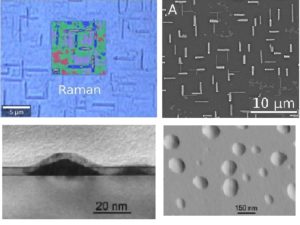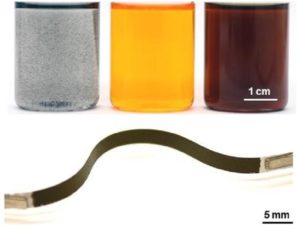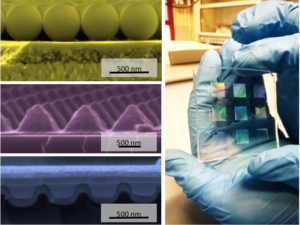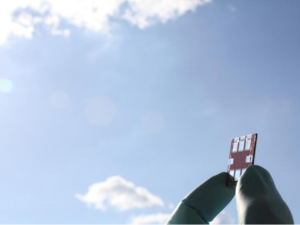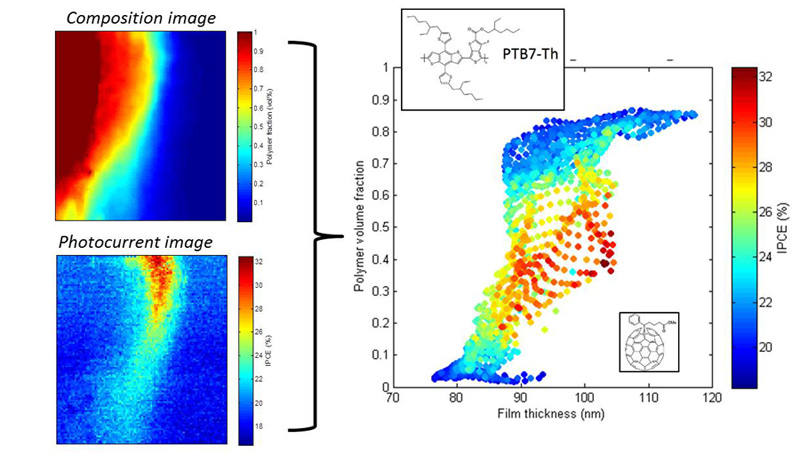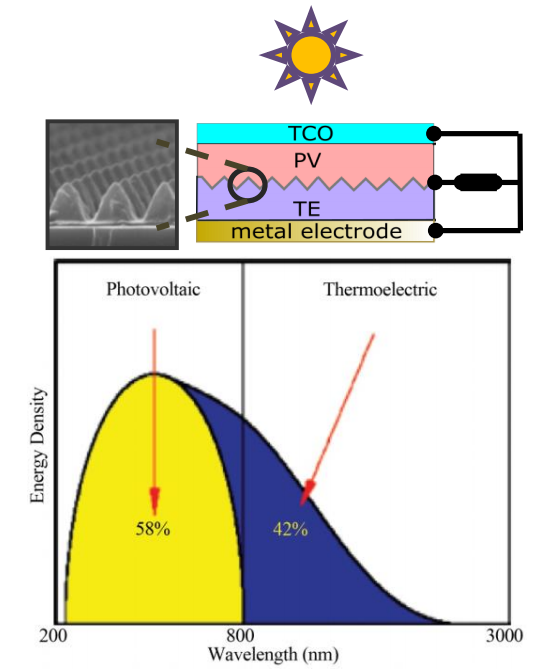HORATES is short for Hybrid and Organic Thermoelectric Systems. We are an international doctoral programme in materials science and funded by the European Union with about 4 million euros. The programme focuses on the development of organic materials suitable for converting unused waste heat into electricity. Within HORATES, 15 young scientists conduct research on this topic and work on their PhD projects. Our consortion includes universities, research centres, and companies in Germany, Italy, Sweden, Spain, the Netherlands and France.

Waste heat from technical devices and even heat given off by living beings is a ubiquitous source of energy and can be harnessed to produce electricity. One possible application is powering small sensors. “We intend to use a mechanism known as the thermoelectric effect to convert the energy, whereby a difference in temperature can be transformed into electrical energy,” says Prof. Dr. Martijn Kemerink of Heidelberg University, Germany, who is the coordinator and spokesperson for HORATES. Until now, inorganic materials have been used for converting and storing energy. The international PhD programme will concentrate on developing organic materials, whose greater mechanical flexibility and low thermal conductivity make them potentially more efficient performers than conventional inorganic materials.
The current state of technology in organic thermoelectrics is not yet far enough for market-ready applications. “For thermoelectric generators, we will explore the properties and processing of newly developed organic materials and then use them in demonstrator devices.” The doctoral candidates work through the full chain of organic thermoelectrics, from molecular design and chemical synthesis to device development, including theoretical modelling. The structured programme for 15 doctoral candidates is organised under the auspices of an innovative training network with scientific and practical experts serving as advisors. Funding is provided within the framework of Horizon 2020, the research and innovation programme of the European Union.
More information here.

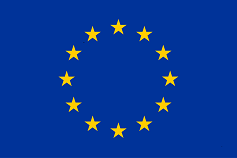
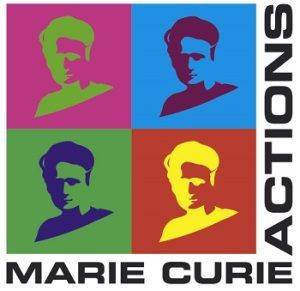


- PI: M. Isabel Alonso
The aim of the call is to promote the activities of the Catalan research groups in order to strengthen the scientific, economic and social impact of the research, as well as to promote its international projection.
The Nanostructured Materials for Optoelectronics and Energy Harvesting (NANOPTO) received a 60.000,00 € grant in the 2021 call (2021 SGR 00444).

- PI: Agustín Mihi
Many products and devices depend on imaging technology, from projection displays to remote sensors. The EU-funded DYNAMO project hopes to achieve a new paradigm in imaging techniques by creating spatial light modulators which can operate simultaneously. Conventional spatial light modulators operate sequentially: a beam of light is shaped into different patterns, and the time interval between patterns is governed by the refresh rate of the device. Instead, researchers propose sending all patterns in one short nanosecond pulse, creating a dynamic spatiotemporal light modulation device. This will result in ultra-fast imaging with a refresh rate for dynamic pixels equivalent to that of the GHz range.
Imaging technologies form the basis of a vast range of products and devices and improvements would have a huge impact both scientifically and commercially. We have identified a key bottleneck, how light is modulated in the imaging system, that we can unlock to achieve a new paradigm in imaging technologies. Spatial light modulators, and similar components, operate sequentially: the light beam is shaped in different patterns but the time interval between patterns is limited by the refresh rate of the device. We will remove this limitation, thereby creating a technological breakthrough; our advance will be to send all possible patterns of the device simultaneously, and encoded in a short nanosecond pulse, creating the concept of parallel beam shaping or dynamic spatio-temporal light modulation device. In Dynamo, we will shape optical beams in two spatial dimensions plus the temporal one. The equivalent refresh rate of the dynamic pixel will start at GHz, although we are confident it will become much higher by the end of the project. To give an idea of our ambition, we compare this improvement in the time to process images with the improvement in the clock frequency of computers: the first general-purpose electronic computer, the ENIAC, had a clock frequency of 100kHz in 1945. It was not until 2000 where AMD reached 1 GHz in their computers. Processing images is broadly similar to processing data so this is indicative of the fifty-year acceleration in the realm of imaging that we will achieve. Dynamo is an ambitious and integrated project that begins by studying the fundamentals of acoustic wave scattering and ends by developing ultra-fast imaging applications in optics. The success of this pathway requires the synergy of the disciplines of physical acoustics, photonics and imaging. The outcomes from this project offer to accelerate imaging technologies and place European science and industry at the forefront of the inventions and advances that will follow.
More information here.

- PIs: Mariano Campoy-Quiles and Alejandro R. Goñi
A much larger contribution from renewables is required in the Spanish energy mix in order to meet the ambitious targets set by the government to help mitigating climate change effects, as well as to ensure our future energy security. ISOSCELLES aims at contributing to this challenge in two directions: on the one hand, by increasing the efficiency of photovoltaic (PV) technologies based on emerging materials (mainly organic semiconductors); on the other hand, by enhancing the versatility of the technology making it more deployable (i.e. PV optimized on demand depending on the final application). The starting hypothesis is the idea that organic photovoltaics (OPV) do not unleash their full potential due to a compromise between the optical properties and limited charge carrier mobilities. If this compromise can be overcome, more efficient and versatile devices will be available. Therefore, ISOSCELLES proposes two strategies to go beyond this compromise. The first one explores the concept of what is the suitable light spectrum that would lead to the highest possible efficiency for a given absorber. Answering this question can lead to ultra-efficient indoor PV in which emitter and harvester are spectrally matched.
Moreover, it can lead also to highly efficient lateral tandem cells (aka spectral splitting geometry). For the latter, rather than splitting the solar spectrum above/below a given wavelength, we propose to give each cell the best possible spectrum that optimizes the total efficiency. The second proposed strategy by ISOSCELLES is based on the realization that increasing the temperature improves charge transport in organic semiconductors, and thus OPVs operating at mild temperatures (ca 75 ºC) can have higher efficiencies. In this sense, we want to establish the design rules to select materials for hot-OPV operation, as well as provide structures based on IR absorbers and plasmonic resonators that lead to self-heating of the OPVs. Overall, ISOSCELLES is expected to generate significant fundamental knowledge and technology to enhance the efficiency in OPVs, as well as a platform for the development of à-la-carte photovoltaics.


The researcher Dr. Sergi Riera-Galindo apply for a fellowship to address effIcient anD stablE orgAnic photovoLtaics (IDEAL) by combinatorial screening. This fellowship will be carried out in the NANOPTO group of Institute of Material Science of Barcelona (ICMAB-CSIC) under the supervision of Prof. Mariano Campoy-Quiles.
Organic photovoltaics (OPV) are a promising emerging renewable energy technology due to several attractive traits, including the possibility to broadly tune colour and transparency, light weight, insensitivity to the angle of illumination, and very high efficiency under low and indoor illumination. Moreover, their amenability for solution processing at low thermal budgets enables the roll-to-roll (R2R) fabrication of OPV modules, ensuring cost-efficient production in terms of energy and economics. Nowadays, the most important challenge is to transfer the large potential of OPV from lab scale to industry and improving its stability.
The overall objective of IDEAL is the development of highly efficient and stable OPV modules for diffuse light applications such as building integration and powering of internet of things (IoT) sensors.
In this project we will use high throughput fabrication methodology using combinatorial screening to evaluate the performance of a material system much faster than the conventional methods. The big data produced will be analysed by machine learning algorithms to predict the full photocurrent versus composition curves from vary basic molecular descriptors and to determine which are the most important parameters that define the best compromise between efficiency and stability.
The expertise of the researcher on fabrication organic electronic devices by solution processed techniques will be combined with the host group experience in combinatorial screening methodology and the use of machine learning in OPV. This project will be instrumental for the researcher to become a cutting-edge scientist and create his own group.
More information here.


- PIs: Alejandro R. Goñi and Agustín Mihi
PLASMOCRACO2 is an innovative proposal addressing the Grand Challenge of the mitigation of the greenhouse effects caused by massive CO2 emissions. The main goal is the development of a novel technology forthe sustainable capture of CO2 and its catalytic conversion into chemicals of industrial interest. PLASMOCRACO2 is unique inthe following terms: The photocatalytic conversion of CO2 will be accomplished in electrochemical cells sel powered from solar energy through the generation of hot electrons which are injected into the gas molecules driving the CO2 reduction reactions. The hot electrons result from sunlight photoexcitation of plasmons at a nanostructured metalic cathode, serving as catalyst. The plasmonic nanostructure will be engraved onto an organic, CO2-permeable membrane, leading to the formation of a gas-iquid-solid, three-phase reaction interface. The membrane also propities a preset ordering in the reaction processes (gas transport, reduction by hot electrons and ions transport), boosting overall conversion eficiency. The main groundbreaking objectives are: To understand the fundamental processes triggered by hot-electron injection atthe three-phase reaction interface and to design and test a plasmon-driven photo-catalytc convertor, serving as demonstrator. PLASMOCRACO2 would thus yield substantial fundamental knowledge regarding photocatalytic CO2 conversion and, simultaneously, provide exploltable results for immediate applications, contributing to the EU Green Deal.

- PIs: Alejandro R. Goñi and Mariano Campoy-Quiles
This project aims at developing a proof-of-concept device consisting in a spectrum-on-demand light source, called SOLS. It is essentially a spectral shaper illumination device, providing a tunable, spectrally shaped, focused and spectrally split beam, modulated in intensity and/or in a wavelength range with respect to a primary light source. The main goal of the SOLS-PV project is to provide a novel illumination device, highly automatic, that can be used to perform many of the standard photovoltaic tests within one piece of equipment, and thus will help to accelerate material screening, enabling the discovery and optimization of novel multi-component materials for the emergent PV technologies like organic PV, metal halide perovskites PV, all oxides PV, etc. Apart from being capable to produce almost any spectrum on demand, a differentiating innovation of the SOLS light source regarding the current state of the art is that it can deliver two types of outputs:
1) A beam spatially and spectrally split in its wavelength components; a unique capability for illuminating lateral tandem (rainbow) solar cells. To the best of our knowledge, there is no other light source capable of addressing the full characterization (global and of the individual components) of multi-junction solar cells.
2) A spatially and spectrally homogeneous beam of large cross section for homogeneous areal illumination for PV materials characterization. Another unique feature of the SOLS setup is that it allows two characterization devices to be merged into one: A solar simulator for the determination of the power conversion efficiency and an external quantum efficiency (EQE) measuring system. The materials science community would very much profit from counting with a spectral shaping illumination device like the SOLS system for a speedy and exhaustive materials screening and characterization.
In June 2023, the SOLS instrument won the EmErgEnt Award from the Efficient Energy Cluster in Catalunya (Clúster de l’Energia Eficient de Catalunya, CEEC) in the “Llavor” category.
For the group of people behind SOLS, the most important aspect of winning this award is the recognition of the innovation potential of the idea and for all the effort and work associated with the project. It is also worth mentioning that this award has contributed to gaining visibility and exposure for the SOLS project, what gives us more credibility and reputation when looking for potential partners/interested companies/investors…


More information on the award can be found here and at ICMAB’s webpage.
More information on the SOLS patented instrument here.

The aim of SYNATRA is to revolutionise the field of agrivoltaics by integrating transparent organic photovoltaic modules with tailored light absorption into agricultural structures to stimulate a synergistic co-production of energy and plants.
The SYNATRA consortium, led by Eurecat through its Functional Printing and Embedded Systems Unit, is formed by 6 partner organizations, including four research institutes [Institute of Materials Science of Barcelona (ICMAB-CSIC), Institute of Cellular and Molecular Biology of Plants (IBMCP-CSIC, UPV), Institute of Photonic Sciences (ICFO), Institute of Agrifood Research and Technology (IRTA)], one technology centre (Eurecat) and one spin-off SME (VITSOLC).
The green energy transition challenge to move global energy production away from fossil fuels requires innovative, renewable, and cost-effective energy technologies. Most of the current utility-scale renewable energy infrastructures are deployed over large areas in remote regions, which entail major impact on the landscape, imply a large distance gap between power generation and consumption, and compete with agricultural land uses. At the same time, the energy demand of intensive agriculture keeps raising with the automation of crop management systems and the increasing deployment of high-tech greenhouses. The emerging field of agrivoltaics aims at providing solutions to combine both types of production -solar photovoltaic power generation and agriculture- on the same land, by capturing most of the solar energy and mitigating ecosystem impacts. However, the use of conventional opaque c-Si photovoltaic modules in agrivoltaics is fundamentally limited by its direct competition for light utilisation with plant growth, as well as the in homogeneous shadowing effects detrimental for homogeneous crop growth. From an ecotoxicological perspective, agrivoltaics must avoid the use of alternative thin film photovoltaic technologies that contain toxic (Pb-based perovskites, CdTe) or scarce elements (CIGS). In contrast, organic photovoltaics (OPV) have emerged as an incipient player in the photovoltaic industry, with a set of unique properties that position it as a key technology to address some of the challenges associated with the green energy transition. Some of the main differentiators of this environmentally friendly, thin film photovoltaic technology include a great absorption tunability, that enables colour and transparency engineering, and a seamless integration onto any shape and surface. These features cannot be otherwise delivered by conventional Si-based photovoltaic panels and, hence, are key characteristics for target applications where high transparency or high integrability are imperative. Semi-transparent OPVs (ST-OPVs) are gaining due attention in the market of building integrated photovoltaics (BIPV), as they are best suited for power-generating windows or façades, as well as in greenhouse applications.
The customisation of ST-OPV for specific agrivoltaic applications will attempt to provide the optimum conditions for plant growth: controlled light intensity, light diffusion and light composition (spectrum), homogeneous coverage of crop areas and mechanical protection against aggressive elements such as hail, wind, or rain.
The SYNATRA project already catched the attention of spanish press media. Specially, Mariano Campoy was interviewed at RNE. The interview to Prof. Mariano Campoy-Quiles in the program “Las tardes de RNE con Carles Mesa” can be found here from minute 33. Other important Spanish scientific media had also commented the project. More information, as well as a compilation of all the press, can be found at ICMAB webpage.


- PIs: Mariano Campoy-Quiles and David B. Amabilino
The ecological transition requires ways to capture energy that are efficient, stable and renewable. Among all the available technologies that will help reach this goal, organic photovoltaic devices (OPVs) are a range of cells that complement others that are based on silicon or other materials. Their advantages are unique: They are made from Earth abundant, environmentally responsible, have very short energy payback times, and are extremely efficient in low intensity light. Although OPVs have been made with energetic efficiencies close to those of other types of devices, there are important challenges for them to be viable in an environmental and commercial sense, such as their stability that has a direct influence on their sustainability. The overarching objective of this interdisciplinary project is the rapid discovery of highly sustainable, efficient and stable organic photovoltaic solar cells. To do that, we will use combinatorial interface screening with the deployment of functional additives. All the studies will intrinsically employ the principles of green chemistry.
The combinatorial screening will be performed exploiting protocols developed by members of the research team. Broadening the measuring techniques will allow the simultaneous study of efficiency and stability in OPVs made of materials with gradients of composition of the electron donors and acceptors and of the thickness of the film. In parallel, a library of synthetic functional additives will be prepared that are designed to both stabilise the interfaces in the devices as well as favour the transport of electrons across them, facilitating charge separation, a key step in the function of the cells. The true success of the project will be the application of the combinatorial approach to the discovery of optimal composition of donor and acceptor of electrons with specific functional additives for each interface in the devices, so that optimal systems in efficiency and stability can be uncovered that will be useful for commercial OPVs that can be used in the ecological transition. The study of the optimal compositions made separately will lead to an understanding of the structure and charge separation processes and will permit the preparation of large-scale devices with optimal stability, efficiency and sustainability. The impact will be more widely appreciated beyond the present project through application of the combinatorial approach to additives, in an analogous way to the discovery of drugs and optimal combinations of them. Presently, additive screening is done in a somewhat random way without being able to design the systems from first principles.
The present project will allow functional additives to be used and that their final composition is discovered in the most ecological and rapid manner.

The current energy and climate crisis requires the more widespread use of renewable energy. Photovoltaic is an excellent method to supply energy needs with clean and renewable energy from the city. Typically, photovoltaic modules have been installed on large areas of land, or in small installations on the roofs of buildings. It is essential to find new spaces where you can install modules photovoltaic to be able to power electronic devices autonomously, which are essential to create smart cities, such as environmental sensors or devices luminous. However, commercially available photovoltaic modules are difficult to integrate into urban architecture due to its rigidity, opacity or for aesthetic reasons. In recent years, the efficiency of emerging photovoltaic technologies has increased significantly, which has implied its initial commercialization. Among these technologies, organic photovoltaics stands out for its low cost due to its ease of production and the materials used, its flexibility, and the ease to adjust the color and transparency of the photovoltaic modules. Furthermore, the optical properties of organic materials make organic photovoltaics maintain high efficiency with incident light diffuse, which is ideal for urban environments, where sunlight often cannot hit directly.
These characteristics make organic photovoltaics an ideal technology for integration into buildings and urban furniture. In this project, photovoltaic modules will be manufactured with organic materials in from printing methods. Specific combinatorial screening techniques will be used to to accelerate the selection of optimal materials both in efficiency and stability. Also, as proof concept, a model of a bus stop canopy will be created in which a module will be integrated photovoltaic which will power LED lighting. This project is an example for future decisions green and ambitious policies to address climate change.
More information here.


- PI: M. Isabel Alonso
ELASTIC is a joint project within ICMAB-CSIC and the National Yang Ming Chiao Tung University (NYCU) in Taiwan.
The 1st-year joint project focuses on the fabrication and evaluation of self-assembled germanium (Ge) quantum dots (QDs) within self-organized Si-containing matrices (SiO2 and Si3N4) using thermal oxidation of poly-SiGe nanopillars, being produced by unconventional nanofabrication techniques (nanoimprinting by ICMAB) and original (electron-beam lighthographic patterning by NYCU) processes. The so-formed Ge QDs feature process-controlled size tunability, allowing us to probe size-dependent strain, optical bandgap energy for Ge QDs and even effects of quantum confinement and interface scattering on effective dielectric constant, absorption and reflectance of the Ge QDs/Si3N4 systems which are fundamental parameters for advancing the photonic device design and thus, for both photonic and thermal transport applications.
Following extensive online discussion, both groups have defined/designed together the Ge-QDs samples that need to be fabricated in terms of lattice parameters (120 nm–400 nm) and QD sizes (50 nm–75 nm) as well as the spectroscopic characterizations in terms of Raman, ellipsometry, photoluminescence, and thermal conductivity.
The Bilateral Programme aims to stimulate, through its own funding, collaboration between CSIC research groups and research groups from various foreign institutions with which a collaboration agreement has been signed. The expected impact of the programme is to improve the internationalisation of the CSIC through the consolidation of stable scientific cooperation links between CSIC teams and teams belonging to institutions based in the aforementioned countries, by means of work and specialisation stays for research groups from these institutions.

The global demand for cold-chain logistics is surging, driven by changing consumer lifestyles, government legislations to reduce waste and rapid diversification of supply chains. The pressure is particularly felt in the pharmaceutical and medical industries, where many life-saving products such as vaccines, peptides, blood and plasma explicitly require shipping and handling at specific temperatures. The use of time-temperature indicators to provide visual cues for undesirable exposure to elevated temperatures offers the means for cold-chain verification. However, the existing food market indicators cannot fully address the specific challenges posed by the pharmaceutical industry, such as:
i) Small size and flexible form factors;
ii) Low cost for item-level applications and distribution in low-income countries;
iii) Operation at ultra-low temperatures from –20 down to –70 °C for mRNA vaccines.
The ambition of VERITASCAN is to advance a new class of time-temperature indicators, drawing on emerging ‘smart packaging’ concepts and harnessing recent breakthroughs in scalable micro-processing of organic semiconductors realised within my group. Specifically, my team will deliver versatile indicators design based on patterned organic semiconductor films that are erasable on-demand by selection of molecular ‘solvents’. We will optimize the temperature range and accumulative exposure monitoring, as well as validate the commercial viability of the technology via comprehensive field-tests with our industrial partners.
My interim objective is to establish a sustainable value creation model in the market. The long-term goal of VERITASCAN is to introduce transformative user-centred technology that addresses urgent societal needs.
More information here.

- PIs: Agustín Mihi and M. Isabel Alonso
OUTLIGHT is a research project belonging to the modality “not oriented research” (modalidad de investigación no orientada). The main goal of this proposal is to generate knowledge in the ambit of light emission coupled to nanophotonic architectures. We will study how a photonic structure can be coupled to a thin film of light-emitting material to provide pathways for the trapped light to reach the outside media. We will study different nanophotonic architectures sustaining resonant modes that coupled to different emitters result in enhanced photoluminescence, lasing or chiral photoluminescence. We will use a scalable nanofabrication technique to produce our structures in such a way that our findings will be easily implemented in actual devices. To illustrate this later point, we will test our architectures in real light emitting devices as a demonstration of our technology in real applications.


Organic photovoltaics (OPV) could significantly contribute to this, as organic solar cells can be manufactured in efficient and low-cost roll-to-roll processes and are already reaching power conversion efficiencies above 19%. However, in order to have a large impact, the long-term stability OPV has to be improved to obtain lifetimes of many years.
Therefore, OPVStability aims to develop:
(i) an in-depth understanding of the degradation mechanisms and stability-promoting factors of organic photovoltaic materials and solar cells,
(ii) tools to predict the lifetime of organic solar cells and to identify stable structural motifs as well as device architectures and
(iii) innovative strategies to significantly enhance the stability of efficient OPV of the next generation.
OPVStability combines partners from academia and industry with a strong background in OPV and/or specialized scientific methods including theoretical calculations and simulations, experimental degradation studies on single materials, materials combinations and interfaces, accelerated aging and outdoor stability measurements, advanced synchrotron-based analytics, high-throughput experiments and machine learning approaches.
Within OPVStability, ten PhD-students work on this timely and interdisciplinary research project accompanied with an excellent training program comprising scientific skills as well as a comprehensive set of soft and transferable skills.
More information here.



- PI: Agustín Mihi
ICONIC (Integrated COnversion of Nitrate and Carbonate streams) pursues the development of a new technology to remediate water ecosystems that have been polluted due to intense agriculture, farming, and CO2 emissions, using electrolysis, to generate globally used chemicals. In particular, ICONIC seeks to convert damaging species responsible of eutrophication and ocean acidification (namely nitrates and carbonates from seawater) into urea, the most important globally produced C-N chemical. Powered by renewables, this offers a path to closing the carbon and nitrogen cycles. ICONIC proposes an integrated electrochemical approach demonstrating, for the first time, the co-electrolysis of carbonates and nitrates into urea selectively, and industrial relevant currents, from seawater using scalable prototypes. Our innovation stems on the accelerated discovery of new catalysts that, based on non-critical raw materials, activate and couple C and N species; their bottom-up synthesis and assembly into mesostructured electrodes to program reaction environments at high current densities; and their implementation into membrane electrode assemblies, all informed by operando characterizations that inform predictive models to guide in the rational design of the catalyst and system. ICONIC leverages interdisciplinary expertise in the areas of chemistry, electrochemistry, materials science, spectroscopies, and engineering, spanning all scales from catalyst design to system-level implementation. ICONIC’s findings would also have positive impact on water-based electrolysis with great decarbonization potential, contributing to their potential operation using abundant seawater.
More information here.
![]()

Recently, the growing popularity of internet of things (IoT) applications has garnered substantial interest in autonomous off-grid energy harvesters such as organic photovoltaics (OPVs) from indoor-available energy sources namely artificial lights. The success of IoT will rely on avoiding battery maintenance for the billions of sensors postulated to be deployed, using available renewable energy at deployment for powering the sensors. The discovery of novel organic materials and diverse device strategies led to a big leap in the power conversion efficiency (PCE) of OPVs up to 31% under indoor lights. Despite the augmented usefulness of indoor OPVs with record performance, several challenges thus far need to be attempted. The High-throughput optimization for indoor Organic Photovoltaic Energy Systems (HOPES) project introduces a novel concept of combining advanced high-throughput experimentation techniques with a standalone tunable light source. HOPES is interdisciplinary and multidisciplinary and includes the development of highly efficient indoor OPVs along with the scale-up property that is, integration of IoT devices with the high-performance OPV. In HOPES, the researcher will implement a computer-controlled light emitting source to achieve a desirable light spectrum by exploring a large library of illumination spectra. This will lead to achieving the highest possible PCE (> 40%) for a given OPV system. The traditional experimental techniques cannot meet the recent progress of indoor OPVs owing to their limitations of time and workforce.
Thus, HOPES will explore a variety of materials at an unbeaten pace by combinatorial screening to reach the highest PCE in indoor OPVs. The researcher’s experience with the indoor OPVs will be combined with the host supervisor’s expertise in high-throughput experimentation to successfully implement HOPES. The advanced training gained during HOPES implementation will contribute to excelling the researcher’s professional career.
More information here.


Finished projects
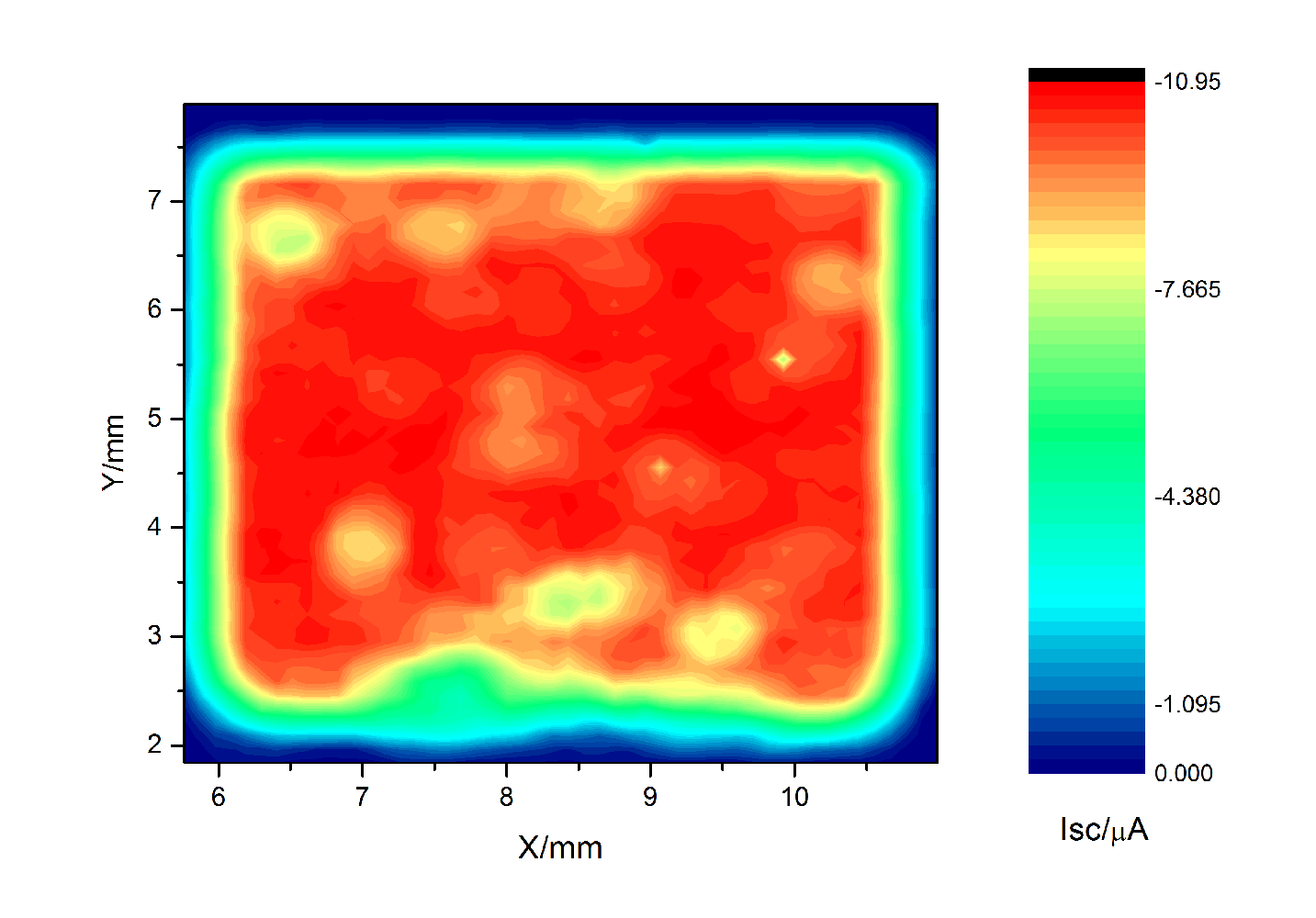
Most members of the group are involved in PHOTOCOMB: Understanding and optimizing nanostructured organic photovoltaics through a processing scheme inspired by combinatorial analysis. This research program runs from 2013 to 2015 and it aims at developing processing schemes that enable the fabrication of organic photovoltaic (OPV) active layers with a controlled graded structure across its area in order to optimize device performance in an effective and speedy manner, as well as to allow fundamental studies on model samples. Inspired by the concept of combinatorial screening, we are studying samples showing continuous variations in one or two parameters, rather than using sets of discrete samples. The gradients span the following main parameters: degree of order, molecular orientation, composition and film thickness. We are implementing experimental setups to perform mapping characterization, in this way, the multiparameter space of the samples is systematically investigated to reveal the most relevant combination governing the performance of organic photovoltaics. During the project we will develop a characterization setup based on optimization for maximum photovoltaic efficiency by implementing an XYZ mapping stage with micrometer precision and a solar simulator to carry out photocurrent maps. We intend to demonstrate the different principles in the widely studied material system, polythiophene (P3HT) mixed with soluble derivative fullerene (PCBM) and then extend it to other systems with higher efficiencies. At the same time, establishing this interplay between fundamental knowledge and performance may help to identify spectroscopic probes that can be used to asses film quality during cell fabrication for in-situ monitoring at industrial level. Non-invasive methods such as ellipsometry and Raman show great potential for this, and the group has many years of experience on its application.
Alejandro Goñi, Mariano Campoy
Amongst the different alternatives for renewable energy production, photovoltaic (PV) and thermoelectric (TE) technologies are being increasingly considered to play a significant role in the future energy mix. This is specially so for small and medium-scale energy generation/harvesting and, particularly, for standalone applications. Furthermore, as in many aspects of nature, synergic properties and/or enhanced performances emerge when combining different but complementary materials into composites (e.g. hybrid materials). The aim of this proposal is twofold: Advance novel hybrid materials and develop hybrid photovoltaic/thermoelectric applications.
Following promising early breakthroughs, progress in the development of high-performance multicomponent organic energy materials has stalled due to a bottleneck in device optimization. FOREMAT will develop a breakthrough technology to overcome this bottleneck by shifting from fabrication-intense to measurement-intense assessment methods, enabling rapid multi-parameter optimization of novel systems. Our goal is to deliver organic material systems with a step-change in performance, bringing them close to the expected market turn point, including panchromatic organic photovoltaics with ca 15% efficiencies and thermoelectric devices that could revolutionize waste heat recovery by their flexibility, lightweight and high power factor. The development of multicomponent materials promises to dramatically improve the cost, efficiency and stability of organic energy devices. For example, they allow to engineer broad-band absorption in photovoltaics matched to the sun’s spectrum, or to create composites that conduct electricity like metals while thermally insulate like cotton yielding thermoelectric devices beyond the state-of-the-art.
Despite these advantages, the long time required to evaluate promising organic multinaries currently limits their development. We will circumvent this problem by developing a high-throughput technology that will allow evaluation times up to two orders of magnitude faster saving, at the same time, around 90% of material. To meet these ambitious goals, we will advance novel fabrication tools and create samples bearing a high density of information arising from 2-dimensional gradual variations in relevant parameters that will be sequentially tested with increasing resolution in order to determine optimum values with high precision. This quantitative step will enable a disruptive qualitative change as in depth multidimensional studies will lead to design rationales for multicomponent systems with step-change performance in energy applications.
More information about FOREMAT
- Additional explanation for the case of high throughput evaluation of materials for photovoltaics can be found in the following press realease (Spanish)
and in the following 9 minutes video (English)
- Video of the full explanation of fabrication of organic solar cells with thickness gradients
PI: Agustín Mihi
The use of these structures within actual devices will be most beneficial for enhanced light absorption in thin solar cells, photodetectors and to develop new sensors and light emitters. However, emerging optoelectronic devices rely on large area and low cost fabrication routes such as roll to roll or solution processing, to cut manufacturing costs and increase the production throughput. If the exciting properties exhibited by the photonic structures are to be implemented in these devices, then they too have to be processed in a similar fashion as the devices they intend to improve. This research line is aimed to develop photonic electrodes that will enhance light matter interaction based on wave optics phenomena while being fabricated with techniques fully compatible with today’s mass production approaches, allowing seamless integration of wave optics components in current devices.

The aim of the project RAINBOW, co-directed by Prof. A.R. Goñi and Dr. M. Campoy-Quiles, is to advance a solar technology that is simultaneously cost-effective and highly efficient. The strategy consists in developing solar energy harvesting devices based on the principle of splitting the solar spectrum into several components, each of which will be absorbed by a solar device with maximum external quantum efficiency (EQE) for the corresponding spectral range. For that purpose, we propose to structure the active layer of the device so to exhibit a lateral gradient in its band gap or a series of adjacent cells with varying band gap, by processing the materials from solution. In this way, energy relaxation losses due to carrier thermalization will be minimized. We thus expect the device to be able to overcome the Shockley-Queisser limit for a single junction, leading to higher conversion efficiencies as compared to conventional solar cells of the same area. We choose devices based on conjugated polymer blends or hybrid lead halide perovskites as we expect then to perform well in a spectral splitting design while being readily processable through low cost methods. A peculiarity of our rainbow design is that the infrared (IR) part of the solar spectrum (1 to 2.5 microns) would be collected by either a solar thermoelectric generator or a plasmon-resonance, cold-cathode thermionic emitter, which would further contribute to enhance power conversion efficiency. The final goal is to obtain a demonstrator of a spectral beam-splitting, rainbow hybrid device with substantially improved solar energy conversion efficiency exploiting the full solar spectrum from the IR up to the ultraviolet spectral range. Therefore, our rainbow approach will yield solar energy harvesters which outperform conventional tandem solar cells in two key points: The overall conversion efficiency improves substantially through harvesting of the IR part of the solar spectrum and including a large number of subcells, and the device fabrication is low cost and technologically uncomplicated.
In the framework of the Marie Sklodowska-Curie Action, call H2020-MSCA-IF-2018, Dr. Luis. A. Pérez was awarded with an Individual Fellowship aiming at advancing sustainable energy production by developing a new class of photovoltaic/thermoelectric (PV/TE) hybrid devices that outperform both the solar cell and the thermoelectric generator working separately. The key concept of Plasmionico is the incorporation of a “cold-cathode” thermionic generator as TE component. In contrast to conventional thermionic generators, where the cathode is brought to extremely high temperatures, in the cold-cathode case, the emission of electrons proceeds from the absorption of infrared (IR) photons in the unused region of the solar spectrum below the PV cell bandgap. The IR photons will launch plasmons at a nanostructured metallic cathode, generating a photocurrent. Apart from its higher efficiency, a great advantage of the thermionic electron emission by photo-excitation of plasmonic resonances is that is not restricted to a particular class of materials, working for Si-based electronic devices as well as for organic (soft and flexible) and/or hybrid perovskite materials, since the cathode temperature is that of a working solar cell. The research activities within this project will span the whole added-value chain from fundamental studies of materials and their adequacy for thermionic generation, including the design and optimization of the plasmonic nanostructures, reaching higher technological readiness levels by implementation of materials and concepts into a proof-of-concept hybrid PV/TE-device.
PIs: Agustin Mihi, M. Isabel Alonso
Surface Enhanced Raman Scattering (SERS) has been a widely exploited technique in the last years. As a versatile and established technique, it addresses both fundamental scientific questions and practical problems. These applied areas are mostly related to sensing of trace substances in many different fields. There are however, several challenges still to be addressed to develop the full potential of SERS in areas such as biosensing. Solid state SERS devices are particularly interesting for the development of portable devices in which the most critical component is the plasmonic substrate. This research plan aims at the design and fabrication of metallic substrates for SERS based in plasmonic crystals operating at several excitation wavelengths, specially towards the NIR region, while maintaing a low cost and high reproducibility.
All members of the group are involved in nanoTHERM bringing together expertise including fundamental Solid State Physics, light-matter interactions and study of electrons and phonons in nanostructures to work towards more efficient thermoelectric materials with good electrical and phonon-blocking, low thermal conductivities. Tailoring electronic and phononic properties of nanomaterials: towards ideal thermoelectricity is a CONSOLIDER research program that runs from 2010 to 2015. It aims at producing a considerable breakthrough in the understanding of the fundamental physics underlying thermoelectricity to produce next-generation thermoelectric materials and devices. Nine groups form the core of an interdisciplinary community covering from theory to experiment and technology to achieve validation of the materials in terms of their suitability for end-users. The group at ICMAB coordinates the work package devoted to synthesis of nanostructured inorganic and hybrid materials, and is mainly developing the design and fabrication of inorganic semiconductor-based nanostructures such as superlattices (SLs), nanowires (NWs) and quantum dots (QDs) with the explicit purpose of exploiting the reduced dimensionality to enhance TE power. The SiGe nanostructures fabricated using Molecular Beam Epitaxy are compatible with all-Si technology, thus enabling monolithic integration with established Si processing, for example as on-chip coolers. Their study is also expected to lead to deep insights about the currently rather limited understanding of the flow heat control and the effect of dimensionality on the heat transport in SiGe and other superlattice structures. The group is also focused on the preparation of new generations of organic thermoelectric materials for evidencing the critical phenomena and the relation structure/properties which allow enhancing the thermoelectric figure-of-merit ZT. Extensive studies of the influence of doping, synthesis routes and chemical composition of soft matter on the properties of charges, phonon transport and on the intrinsic properties of the polymers will be carried out. The group will also dedicate efforts to hybrid structures of engineered organic-inorganic materials, such as colloidal semiconductor QDs in polymeric matrices.
TranspEnergy is framed within a long standing collaboration with the department of ‘Functional Printing & Embedded Devices’ of the technological center Eurecat. Our main goal is to manufacture semitransparent organic photovoltaic modules by roll-to-roll coating techniques with a desired/targeted color range: photovoltaics “a la carte”.
To meet this goal, TranspEnergy includes both optical computer modelling and lab/fab-scale studies. Computational simulations will allow predicting solar devices color and transparency meanwhile lab-scale work let us check both the validity as well as try cost-effectively new materials and device configurations. Finally, the last step is scaling-up, which consists of transfer the know-how from lab-scale to fab-scale.
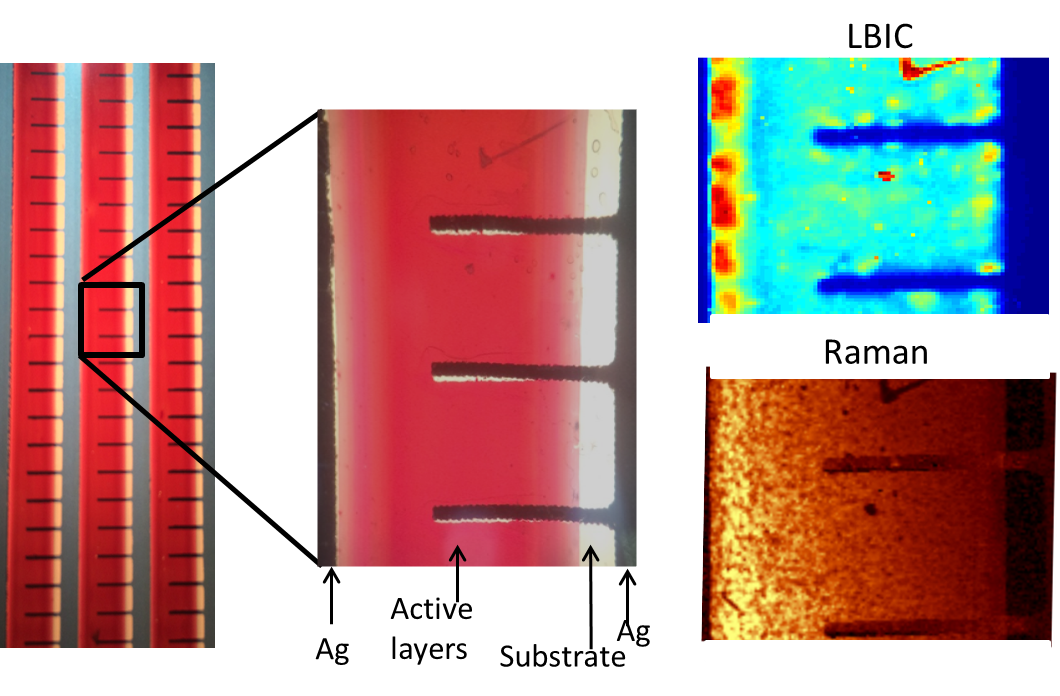
Lab-scale studies will focus on testing several materials and device configurations saving time and resources. Characterization techniques used to evaluate the performance of the devices include LBIC and Raman. LBIC (Laser Beam Induced Current) is used to create a photocurrent map. This technique is a very valuable tool complementing non-localized measurements of the JV-curve. As well, Raman Spectroscopy measurement is used to create a composition mapping. With the perfect matching of this two characterization techniques we can identify defects and materials contribution.
On the other hand, optical simulations based on transfer matrix method predict transparency, color and electrical properties. As input parameters, optical simulations are based on spectroscopy ellipsometry data to experimentally determine optical properties of the device. Furthermore, this method allows to evaluate multi-components blends, which is very valuable to analyze color and transparency sensitivity. Finally, the reverse problem i.e. finding the appropriate material and device geometry that results in a desired color, will also be studied.
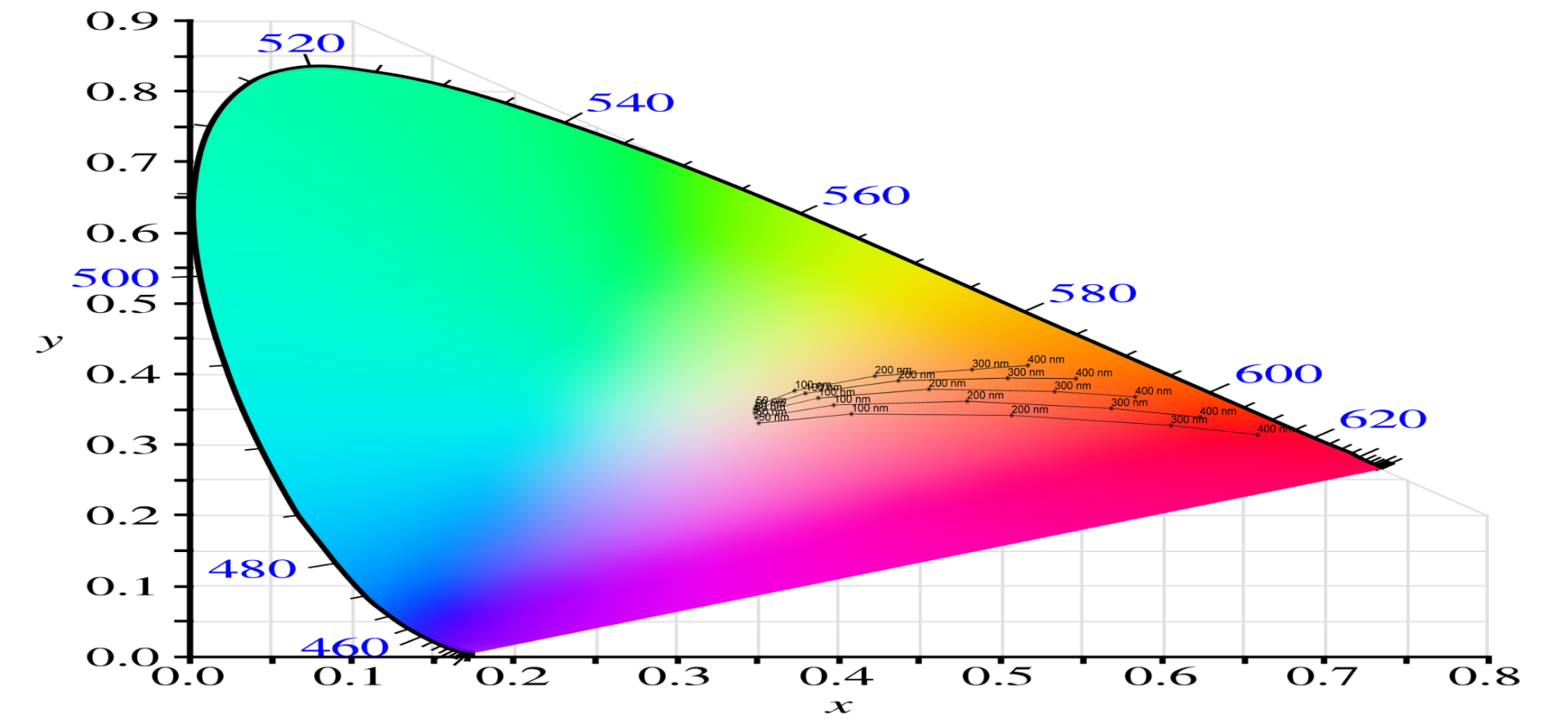
The final aim of this project is to develop active architectonic elements being aesthetic and colored easily integrated in buildings. OPV technology has unique features such as ease of color tunability and transparency, which could be a perfect technology to transform passive windows or skylights for active light-harvesting elements.
KEYWORDS: OPV (Organic photovoltaics), BIPV (Building integrated photovoltaics), color tuning, R2R (roll-to-roll)
EXPLOTHRA is an ambitious project which aims to create a breakthrough in our understanding and ability to control heat transport at the nanoscale. Its main objective is to study thermal transport in the temporal and spatial domains simultaneously. This will provide invaluable information on the nature of heat in different material systems and it will be the key to open novel research fronts. We aim to understand to what extent we can manipulate heat propagation, and explore the potential of heat as exploitable quantity for novel applications in the fields of energy and electronics. The specific question that this project aims to answer is how heat propagates at the nanoscale and on short time scales, i.e., in non-equilibrium conditions. The key objective of the project is to visualize the propagation of heat in extreme slow motion in technologically relevant systems. We will develop an original methodology based on probing time-resolved optical reflectance through an interferometric approach which will provide large sensing capabilities. We will test the technique through standard systems in 1D, 2D and 3D thermal flow geometries. We expect that this technique will become a state of the art technique in nanoscale thermal transport.
TANGENTS is an ambitious project which aims to create a breakthrough in our understanding and ability to control heat transport and temperature sensing at the nanoscale. Its main objective is to study thermal transport with sub-30 nm thermal-spatial resolution and with temperature accuracies below 50 mK. We aim to understand to what extent we can manipulate heat propagation, and explore the potential of heat as exploitable quantity for novel applications in the fields of energy and electronics. The specific question that this project aims to answer is how heat propagates at the nanoscale where the heat transport regime exhibits the transition from ballistic to diffusive. The key objective of the project is to visualize the propagation of heat in spatial scales smaller than the thermal phonon mean free path in technologically relevant systems. The ambitious ultimate purpose of this project is to extend the experimental methodology to the time- domain in order to probe real-time heat propagation with nanoscale resolution.
The mission of the SEPOMO – Spins in Efficient Photovoltaic devices based on Organic MOlecules – is to bring the performance of OSCs forward by taking advantage of the so far unexplored degree of freedom of photogenerated species in organic materials, their spin.
This challenging idea provides a unified platform for the excellent research to promote the world-wide position of Europe in the field of organic photovoltaics and electronics, and to train strongly motivated early stage researchers for a career in science and technology oriented industry that is rapidly growing.
The project SENSORAÏM, aims to improve quality, efficiency and sustainability in viticulture by providing key data in real time across the whole vineyard, with autonomous sensors based on organic thermoelectric generator technology.
In a first step, temperature and humidity will be monitored by installing a network of distributed autonomous wireless sensors that communicate with a central server, and from there with the cloud and an application on the mobile phone of the winegrower. These data will help to prevent the effects of frost and drought, as well as to fine-tune the drop on demand watering of plants at the different regions of the vineyard, and obtain data to help preventing plagues. In a second phase, other parameters might be monitored, such as ground pH or nutrients as relevant parameters that will enable the implementation of real-time smart irrigation systems.
The power autonomy of the sensor is achieved thanks to our unique generators. Throughout the past three years, we have developed a patented organic thermoelectric generator technology, a device that uses small temperature differences in the environment to generate enough power to supply simple sensors. Compared to traditionally used batteries, our solution is more environmentally friendly as it does not involve toxic elements, while also being cheaper in the long run, since our generators do not require maintenance.

